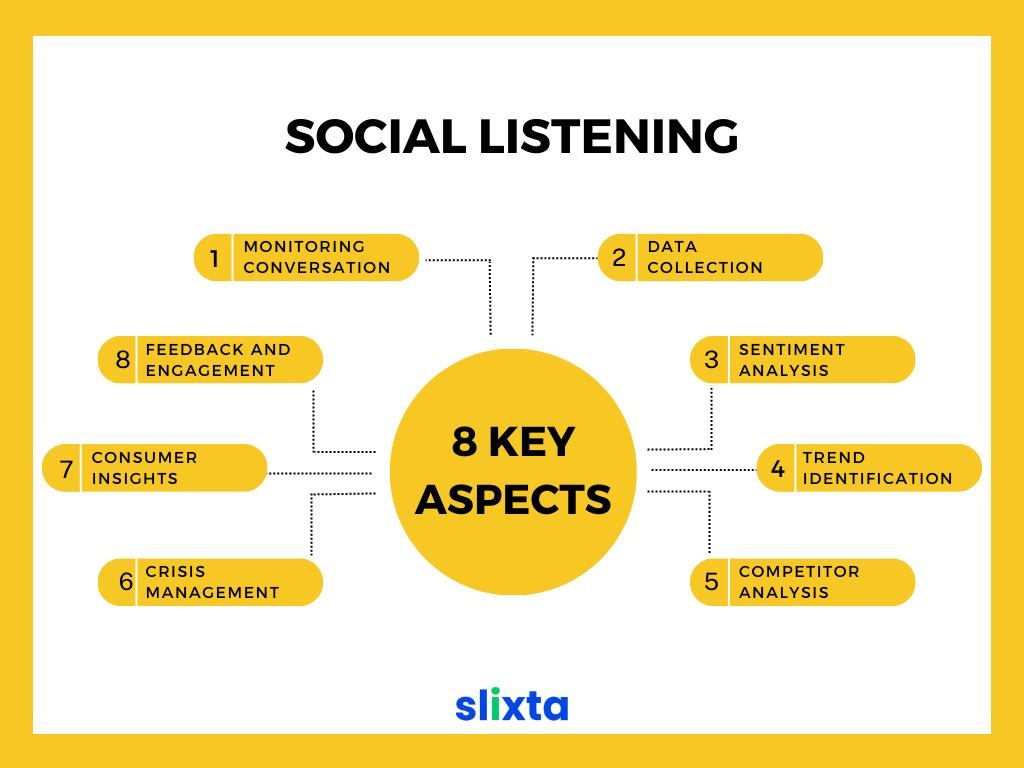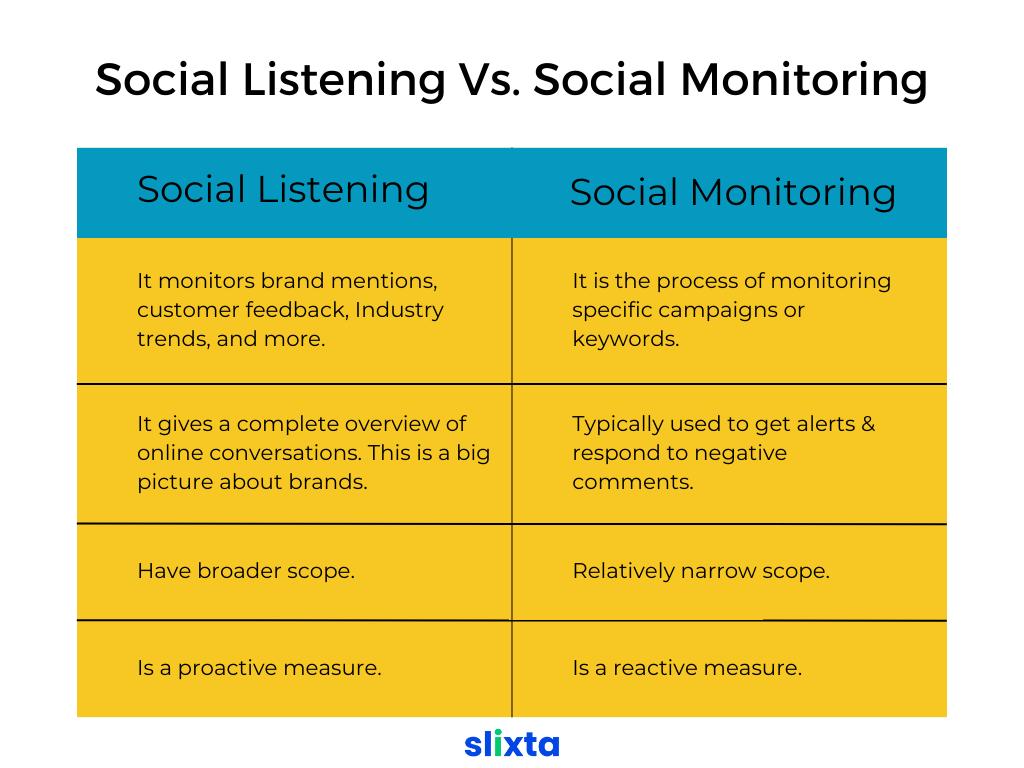
What is Social Listening? Strategies for Business Success with Social Media Insights
Aug 30, 2023
Social listening involves monitoring online conversations, such as on social media platforms, to gain insights into public opinions, trends, and brand perception. It helps businesses understand customer feedback, industry trends, and competitor activities, allowing informed decision-making and proactive engagement.
Did you know that a 2022 Morning Consult survey discovered that 54% of Generation Z spend a minimum of four hours daily on social media? With Gen Z's increasing influence on the global economy, this presents a substantial opportunity for brands.
Social media has become a prime platform for people to express their opinions about brands. Brands often interact with customers through tweets, LinkedIn replies, and Instagram comments. This dialogue showcases people's sentiments, and brands can utilize this to foster loyalty.
Social Listening actively monitors and analyzes these digital conversations. It's more than observing – it's a dynamic strategy to understand the sentiment, detect trends, and engage in real-time. Social listening empowers brands to manage their reputation, seize opportunities, and refine strategies based on genuine customer insights.
Let's explore the depths of social listening,
What is Social Listening?
Social listening refers to the process or strategic practice of monitoring and analyzing online conversations, discussions, and mentions related to a particular brand, product, topic, industry, or any other subject of interest. It involves tracking mentions and discussions across various social media platforms, blogs, forums, news sites, and other online sources. The goal of social listening is to gain insights into public sentiment, opinions, trends, and discussions in real-time or over a specific period.
Key Aspects of Social Listening
Key aspects of social listening include:

Monitoring Conversations
Social listening tools track mentions of specific keywords, hashtags, brand names, or topics across social media platforms and other online channels.
Data Collection
These tools gather data from various sources and compile them into a comprehensive dataset for analysis.
Sentiment Analysis
Social listening involves determining the sentiment behind the conversations—whether they are positive, negative, or neutral. Sentiment analysis helps businesses understand how their brand or product is perceived by the public.
Trend Identification
By analyzing large volumes of data, social listening can uncover emerging trends, popular topics, and recurring themes within online conversations. This information can be used for marketing campaigns, content creation, and strategic decision-making.
Competitor Analysis
Social listening allows businesses to monitor their competitors and gain insights into their customers' opinions, preferences, and pain points. This information can be valuable for refining their own strategies.
Crisis Management
Social listening enables organizations to detect potential PR crises or negative sentiments early, allowing them to respond and take appropriate actions to address concerns before they escalate.
Consumer Insights
By analyzing social media conversations, companies can gain a deeper understanding of their target audience, their needs, desires, and behaviors.
Feedback and Engagement
Social listening provides a way for brands to engage with customers, respond to feedback, and participate in relevant conversations, thereby building stronger customer relationships.
Social Listening Vs. Social Monitoring

How Does Social Listening Help Brands?
Understanding the Audience
Social listening is a direct window into the minds and hearts of your audience. By monitoring conversations, comments, and discussions, brands gain valuable insights into what their customers truly care about, their preferences, pain points, and interests. This granular understanding allows for more targeted messaging, personalized offerings, and enhanced customer experiences.
Crisis Management
In the age of real-time communication, negative sentiments, and crises can spread rapidly. Social listening enables brands to promptly detect and address potential PR crises, negative reviews, or customer dissatisfaction. By responding promptly and transparently, brands can mitigate the impact of negative situations and maintain their reputation.
Harnessing Brand Loyalty through Customer Interactions
Engaging with customers directly on social media platforms nurtures a sense of connection and loyalty. When customers see that brands value their feedback, respond to their queries, and actively participate in conversations, it enhances brand affinity. This positive interaction often translates into increased customer loyalty and advocacy.
Understanding Industry Trends
Social media is a hotbed of discussions about industry trends, emerging technologies, and evolving consumer behaviors. Through social listening, brands can identify these trends in real-time. This information not only keeps brands up-to-date but also positions them as thought leaders in their respective industries.
Discovering New Opportunities
Beyond understanding trends, social listening can uncover new market opportunities. By analyzing conversations, brands might identify unmet needs or niche markets that can be tapped into. These insights could lead to the development of innovative products, services, or marketing strategies that resonate with specific customer segments.
Competitor Insights
Social listening provides a way to keep a pulse on competitors. By monitoring conversations about competitors, brands can gain insights into their strengths, weaknesses, and customer sentiment. This information can guide competitive positioning and differentiation strategies.
Enhanced Customer Experience
Through social listening, brands can proactively address customer queries, concerns, and feedback. This improves customer satisfaction and loyalty by demonstrating that the brand values its customers' voices and is committed to addressing their needs.
Social Listening Tips
Define Clear Objectives
Set specific goals for your social listening efforts. Whether it's understanding customer sentiment, monitoring competitor activity, or tracking industry trends, having clear objectives will help you focus your efforts effectively.
Select Relevant Keywords and Topics
Define the keywords, hashtags, and topics you want to monitor. Be comprehensive, including variations and synonyms, to capture a broader range of conversations.
Refine Filters
Use filters to eliminate noise and focus on relevant conversations. You can filter by sentiment, location, language, and more to narrow down the data to what's most pertinent.
Monitor Multiple Platforms
Social conversations occur across various platforms. Monitor not only major platforms like Facebook, Twitter, and Instagram, but also industry-specific forums, blogs, news sites, and niche communities.
Analyze Sentiments
Utilize sentiment analysis tools to gauge whether conversations are positive, negative, or neutral. This helps you understand overall public perception and identify areas that need attention.
Engage Authentically
When responding to conversations, be genuine and authentic. Avoid generic responses and tailor your engagement to the specific context of the conversation.
Stay Ethical
Respect user privacy and data protection regulations while conducting social listening. Ensure that the data you gather and analyze is done in compliance with relevant laws.
Social Listening Done Right
Airbnb
In 2022, Airbnb showcased the impact of social listening. A TikTok influencer encountered a hotel issue and shared a video that garnered 3.9 million views. Airbnb swiftly reacted by offering a complimentary stay within 24 hours. The influencer's positive response generated millions of views and impressions, valued at around $70,000 in advertising. This event highlighted how social listening can yield significant brand exposure.
Fitbit
Fitbit is a cool brand that loves connecting with its customers on social media. They've come up with a nifty feature called 'Reminders to Move' using a neat trick called social listening. Basically, this feature gives you a friendly nudge to stretch your legs and move around a bit. It's like having a virtual buddy that reminds you to get up and groove a little!
Conclusion
Social Listening is not just eavesdropping, but an active strategy to understand moods, find trends, and join the chat. Social listening helps brands manage their rep, spot opportunities, and fine-tune plans using real customer thoughts. It helps brands build loyalty, respond to problems quickly, and even spot new ideas. Imagine knowing what your audience loves and needs in real-time!
For more valuable insights and information, check out these recommended blogs:
